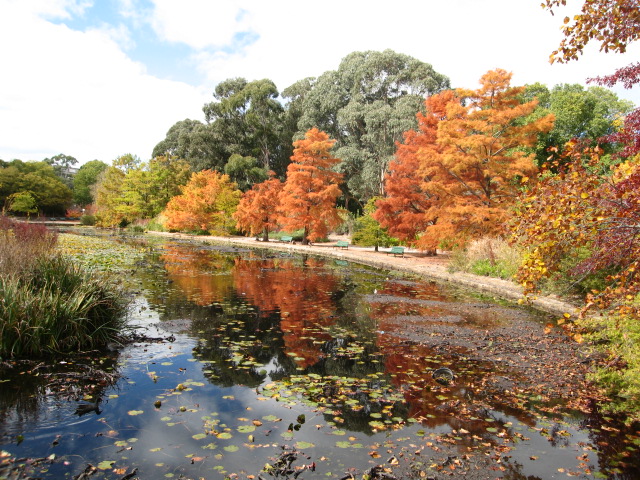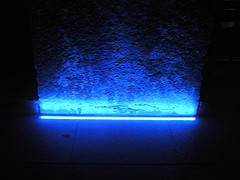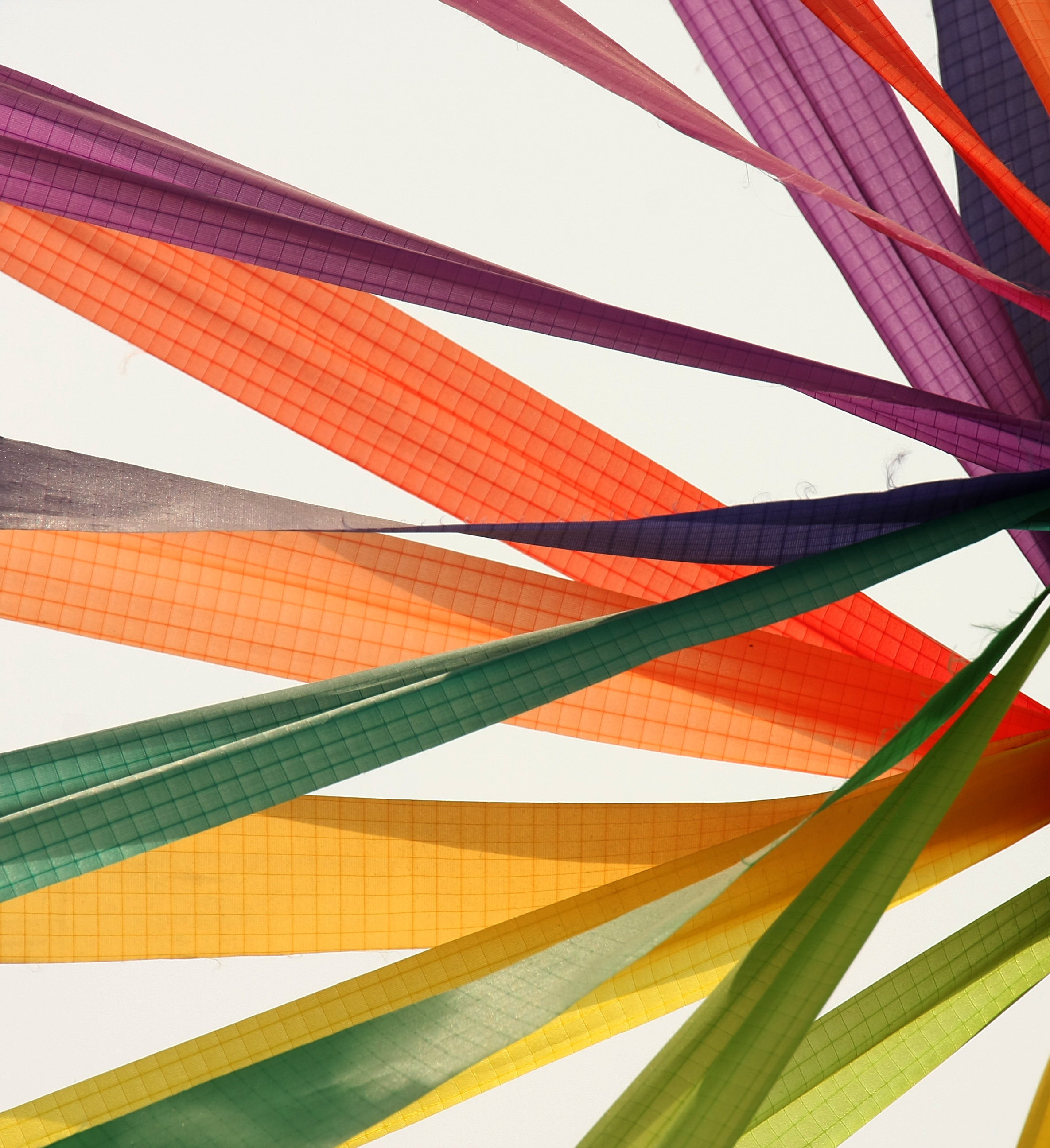Got the Blues? How Plants Respond to Blue Light
Posted by Linda, on 28 April 2011
Physiologically speaking of course…
As mammals we have biological clocks, or circadian rhythms that respond to light. Dark or blue light set off signalling mechanisms, which ultimately regulate the melatonin levels in our system. Melatonin is a hormone which can induce sleep, if at sufficiently high levels in our system. (Hence your doctor prescribing you melatonin if you have trouble sleeping at night. Suffice to say countless grad students are probably on this stuff right now). (Photo: Festival Colours by jmtimages, Flickr CC)
 Plants also have a light-sensing system, which can respond to different times of day and seasonal changes. This can determine fruit maturation and changing colour in the leaves etc. For plants, blue light has a revitalizing (instead of drowsy) effect. If you’ve ever left your plants without light for too long, they go yellow. Irradiate them with a little blue, and the green will return within a couple of days. (Photo: Autumn Colours in Australia’s National Capital, personal collection).
Plants also have a light-sensing system, which can respond to different times of day and seasonal changes. This can determine fruit maturation and changing colour in the leaves etc. For plants, blue light has a revitalizing (instead of drowsy) effect. If you’ve ever left your plants without light for too long, they go yellow. Irradiate them with a little blue, and the green will return within a couple of days. (Photo: Autumn Colours in Australia’s National Capital, personal collection).
Interestingly, plants and animals have the same type of photoreceptors to blue light, called Cryptochromes (CRYs), even though they elicit a different response. (Photoreceptors = light absorbing molecules or pigments.)
CRYs initiate the light response, analogous to a molecular domino effect. The pigments bind specialized proteins that in turn, regulate transcription factors that can switch on the light response genes involved in development. Termed as photomorphogenesis, light dependent changes in development can include initiation of flowering, or extension of roots in germinating seeds.
Currently, characterizing the molecular interactions in the plant blue-light/CRY1 response seems to be a hot topic. Two highly similar articles were just published in Genes & Development, which was drawn to my attn by Eva (cheers). They were produced by two different research crews, using virtually the same methods to similar results. It’s not by total coincidence either. Characterizing molecular interactions in plants involve the same gold standard biochemical and genetic assays (i.e. transgenic plants, yeast hybrid systems, loss-of-function mutants etc.)
In summary: the blue-light/CRY1 pathway doesn’t directly switch genes on. instead, it switches off the default dark condition mechanism. In the dark, SPA1 and COP1 proteins negatively regulate the light signalling pathway. Active COP1 normally marks transcription factor HY5 for degradation. SPA1 binds COP1 to enhance this activity. If HY5 were allowed to accumulate, it promotes the expression of multiple genes involved in photomorphogenesis, such as flowering, or germination.
 What the groups found: Blue-light triggers CRY1 to bind SPA1. This in turn inhibits SPA1 binding to COP1. In 2001, another group found that CRY1 can also interact directly with COP1 to inhibit its activity in a 2nd way. Result: no COP1 activity, HY5 accumulates. Photomorphogenesis is observed. (CRY1 could not bind SPA1 in the dark, or under red light).
What the groups found: Blue-light triggers CRY1 to bind SPA1. This in turn inhibits SPA1 binding to COP1. In 2001, another group found that CRY1 can also interact directly with COP1 to inhibit its activity in a 2nd way. Result: no COP1 activity, HY5 accumulates. Photomorphogenesis is observed. (CRY1 could not bind SPA1 in the dark, or under red light).
(photo: blue light, by psychiks, Flickr CC. does this make you feel sleepy?)
Some discordance over the CRY1-SPA1-COP1 interaction: One group claims that CRY1 causes SPA1 to dissociate from COP1. (exact mechanism unclear, allosteric binding = conformational change?) the other group suggests that CRY1 impedes COP1 and SPA1 binding, possibly by sandwiching itself between them. Refer to sandwich model in Liu et al. 2011 Figure 4D, or kit-kat dissociation model in Lian et al. 2011 Figure 5G. Devil’s in the details: both groups developed their models based on two biochem assays ~ yeast two/three hybrid and co-immunoprecipitation. However, they only tell you if things bind or not. Interestingly, blue-light and CRY1 were required to prevent SPA1 and COP1 binding. Under blue light, CRY1 could bind both COP1 and SPA1, just not sure how.
The interaction hasn’t been characterized in animals, although they do contain the CRYs. Mammals even have COP1, which can also mark other transcription factors for degradation. Inexplicably, breast cancers were found to have over-expressed levels of COP1. Not sure if CRY also inactivates mammalian COP1, although, one group did stick the mammalian COP1 into Arabidopsis, and found it reacts to blue-light. Interestingly, photoreceptors and COP1 were initially found in Arabidopsis. (score 1 for the plant model of genetics).
Liu B, Zuo Z, Liu H, Liu X, & Lin C (2011). Arabidopsis cryptochrome 1 interacts with SPA1 to suppress COP1 activity in response to blue light. Genes & development PMID: 21511871
Lian HL, He SB, Zhang YC, Zhu DM, Zhang JY, Jia KP, Sun SX, Li L, & Yang HQ (2011). Blue-light-dependent interaction of cryptochrome 1 with SPA1 defines a dynamic signaling mechanism. Genes & development PMID: 21511872
Both research groups hail from China and the US. They’re also based in some of the top universities in the world (Peking Uni, UCLA etc.), which makes for some hefty competition, among neighbours no less.
Human Photoreceptors and COP1:
Yi C, & Deng XW (2005). COP1 – from plant photomorphogenesis to mammalian tumorigenesis. Trends in cell biology, 15 (11), 618-25 PMID: 16198569
Yi C, Wang H, Wei N, & Deng XW (2002). An initial biochemical and cell biological characterization of the mammalian homologue of a central plant developmental switch, COP1. BMC cell biology, 3 PMID: 12466024
Cashmore AR (2003). Cryptochromes: enabling plants and animals to determine circadian time. Cell, 114 (5), 537-43 PMID: 13678578



 (2 votes)
(2 votes)
I have been interested in blue / red light with reference to climate change , and the influence on plants and animals if we start interfering with aerosols in the atmosphere and this may reflect some heat and light back to space , but what effects may it have on the blue/red in the light spectrum and really disturb the plant growth and animal behavior on the surface to the planet , and with what effects on mankind?
Hi David, that’s a really interesting and complex question. I can only guess what might happen (I’ll try to deflect your q at a plant ecologist for their expert opinion). Air pollution from aerosols reduces visibility across the spectrum. And plant growth would be vulnerable to poor light quality, as they rely on light to make food and signal in developmental changes. blue and red light mediate an array of processes in the plant. To list off, developmentally, constant low red/blue light can cause morphological changes like delayed maturation of certain tissues, reduced root mass, longer stems to allow plants to reach the light etc. (refer to article at the end). Blue light is also important in the production of chlorophyll, required in photosynthesis (making food). Red light can signal when to photosynthesize.
However, plants are also robust, their photoreceptors are capable of sensing low light intensities, to a degree. (Hence some plants under a dense rainforest canopy being able to grow). If low light stress is perpetual from climate change, it can change a plant community. Species already adapted to low light will thrive and outcompete other types that require more light. For agriculture, constant low light stress would be bad for crops that require higher light intensities (could wind up with lower yields).
But, light quality wouldn’t be the only thing that air pollution would impact. The hole it creates in the ozone allows more UV light to come in, greenhouse effects traps infrared wavelengths = increasing temperatures. etc. It’s a host of different stresses that probably have additive effects. Of course, indirectly, this is bad for animals, as we rely on plants for food and infrastructure.
Animal behaviour wise, I’m not sure (i’d have to ask someone studying neuroscience/behaviour), blue/red light would have to be blocked quite significantly I gather, before everyone’s biological clock is off-balance. Grey skies from smog and air pollution can cause mood changes, similar to seasonal affective disorder.
I found this encyclopaedia of earth article quite helpful, ‘impact of air pollution’ by a head of environmental research. Also, some research on blue/red light on plant ecology (hopefully it’s not too intense): Development and Shade avoidence in response to blue and red light
I recently purchased a LumiGrow Pro 325 which is a state-of-the-art LED greenhouse lighting fixture. I am using it indoors with no other light source. The fixture provides red, far red, blue, and white light. The intensity of each can individually controlled with setting numbered 1 thru 10. Little to no heat is produced. I placed freshly germinated seedlings, 12 hours past breaking ground, under the lights with the settings for all three frequencies at 5 and at a distance of 24 inches. Within 2 hours the seedlings grew to a height of 2 inches then fell over in a condition similar to what would have been consistant with damping off but the stems were not shrunken at the base. The growing medium was sterile so damping off was not a factor. Are there any studies showing light toxicity of red, blue, or white wavelengths at greater than natural light intensities?